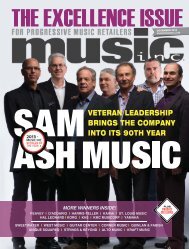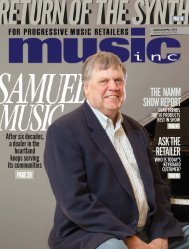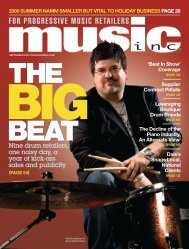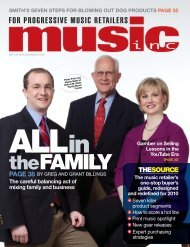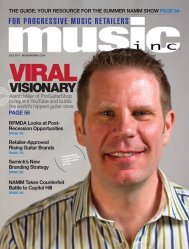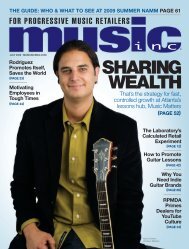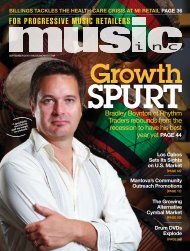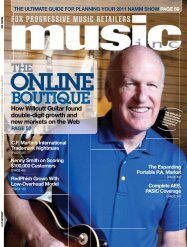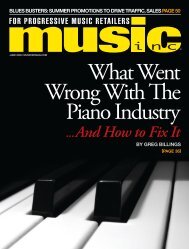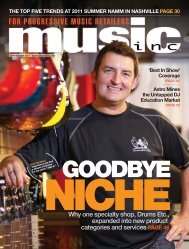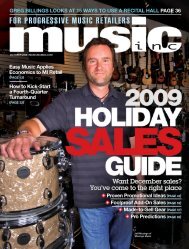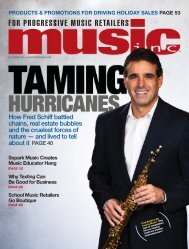Create successful ePaper yourself
Turn your PDF publications into a flip-book with our unique Google optimized e-Paper software.
8 I MUSIC INC. I OCTOBER 2010<br />
PERSPECTIVE I BY ZACH PHILLIPS<br />
<strong>SCHOOL</strong> MUSIC<br />
LIFE SUPPORT<br />
Iknow firsthand that NAMM’s Support <strong>Music</strong> works. How? Four years<br />
ago, I watched <strong>Music</strong> <strong>Inc</strong>. Publisher Frank Alkyer help save his district’s<br />
junior high music program using little more than Support <strong>Music</strong>’s Web site.<br />
Alkyer found out that the junior high was squeezing band and orchestra<br />
out of the curriculum, relegating them to after-school activities. He<br />
jumped on supportmusic.com’s Make Your Case page and crafted a counterargument<br />
using its simple checklist-style template. A<br />
round of e-mail exchanges got his letter circulating<br />
among PTA members. When the next school board<br />
meeting rolled around, he had an army of new advocates<br />
for the program.<br />
More than 50 of these parents went before the<br />
board to make their case. They spoke passionately<br />
about how music education keeps kids out of trouble.<br />
They cited Support <strong>Music</strong>’s research. They were the<br />
only people who bothered coming to the meeting.<br />
To put it lightly, folks on the school board heard<br />
what the community wanted. The program stayed put.<br />
This month’s cover story, “School <strong>Music</strong><br />
Advocates,” features accounts from several retailers<br />
who’ve made an art of saving programs — often using<br />
Support <strong>Music</strong> and other NAMM-sponsored resources. (It begins on page<br />
50.) We’ve timed the article to coincide with what may prove to be one of the<br />
toughest years ever for school music. Learn from these dealers’ examples.<br />
Mobilize parents to fight for programs at risk, or even better, make a pre-emptive<br />
strike to preserve stronger programs. In this climate, none is safe.<br />
Sadly, George Quinlan, president of Quinlan & Fabish in Burr Ridge, Ill.,<br />
pointed out in his contribution to the article that sometimes “the water is<br />
too deep, and cutting a program is the only solution.” When traditional<br />
advocacy fails, there are still options. Most notably, Quinlan has coped by<br />
hosting fee-based after-school programs. These meet five days a week and<br />
cost students roughly $30 a month. Tuition payments are made to his sister<br />
corporation, <strong>Music</strong> World Service, to prevent confusion among customers.<br />
Most of the tuition goes to the teacher, with a small percentage to cover<br />
administration expenses.<br />
“Since the mission of [World <strong>Music</strong> Service] is to provide temporary<br />
assistance until the program can be restored by the school district, Quinlan<br />
& Fabish absorbs many of the expenses to achieve that objective,” Quinlan<br />
said. “We consider it an investment in our future.”<br />
Yes, fee-based programs aren’t ideal. They’re time-consuming. They<br />
require a good relationship with school administration just to get off the<br />
ground. And ironically, they’re almost exactly what Alkyer was fighting<br />
against four years ago.<br />
That said, they’re better than no program at all. And for Quinlan,<br />
they’ve kept several band programs afloat during tough times — programs<br />
that went on to be reinstated once funding returned. MI



